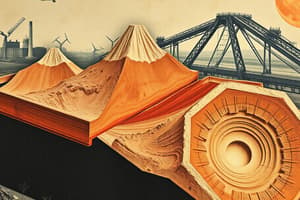Podcast
Questions and Answers
What drives the movement of Earth's continents according to the text?
What drives the movement of Earth's continents according to the text?
- Ocean currents
- Plate boundaries
- Atmospheric pressure
- Super hot semi-solid mantle (correct)
What is the primary heat source maintaining convection in the mantle according to the text?
What is the primary heat source maintaining convection in the mantle according to the text?
- Atmospheric gases
- Energy from Earth's formation (correct)
- Ocean currents
- Solar radiation
What geological process leads to magma being pushed up along ridges like in Iceland?
What geological process leads to magma being pushed up along ridges like in Iceland?
- Crustal uplift
- Subduction
- Glacial melting
- Mantle plumes (correct)
In collision zones, why do heavier tectonic plates dive under lighter ones according to the text?
In collision zones, why do heavier tectonic plates dive under lighter ones according to the text?
Despite our understanding of plate tectonics, what remains unknown according to the text?
Despite our understanding of plate tectonics, what remains unknown according to the text?
Study Notes
- Earth's geological history involves the formation and breakup of supercontinents, starting with Creighton and Er, leading to the eventual formation and breakup of Rodinia, then Pangaea.
- The movement of Earth's continents is driven by the slow movement of the super hot semi-solid mantle beneath the rigid tectonic plates, creating convection cells or convective flow.
- The heat source maintaining this convection is primarily leftover energy from the Earth's formation, as well as heat released from radioactive decay of materials like uranium in the mantle.
- Magma is pushed up along ridges, such as in Iceland, causing plates to move apart, while in collision zones, heavier plates dive under lighter ones due to gravity, pulling them back into the mantle.
- Despite our understanding of plate tectonics, the specifics of the processes in the deepest parts of the Earth that drive these movements may remain unknown.
Studying That Suits You
Use AI to generate personalized quizzes and flashcards to suit your learning preferences.
Description
Test your knowledge on the geological history of Earth, including the formation and breakup of supercontinents like Rodinia and Pangaea. Learn about the driving forces behind the movement of Earth's tectonic plates and the underlying processes that shape our planet's surface.




